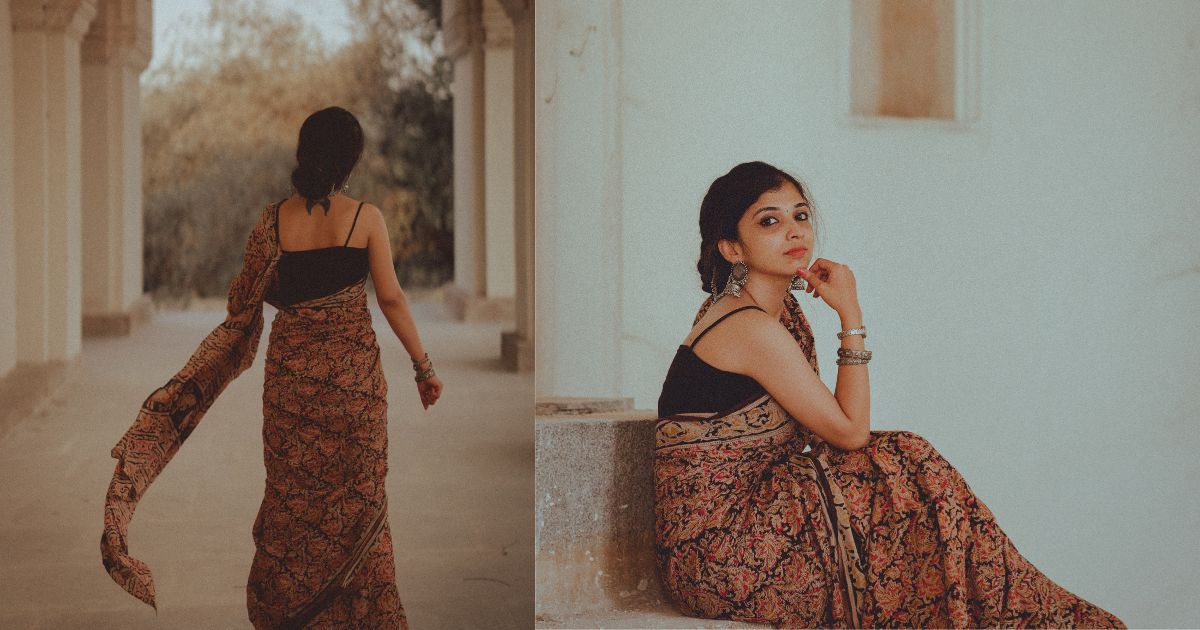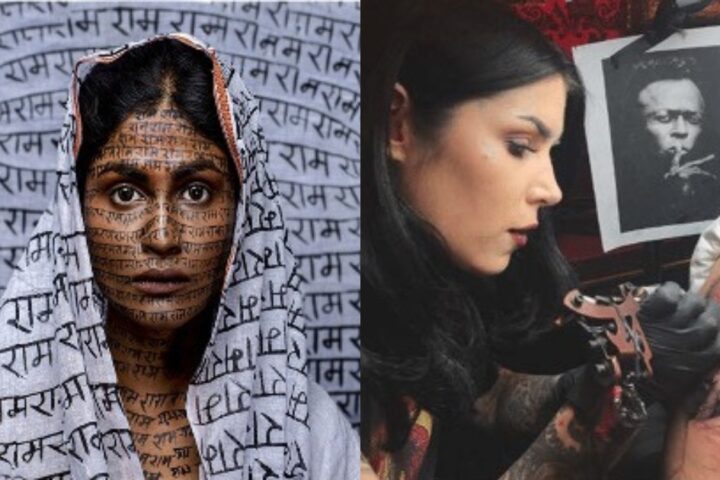Every once in a while, we come across a sappy wedding post that shows the bride in her grandmother’s saree, which she wore as a tribute to her well-kept saree wardrobe. Saree, a nine-yard wonder, is not just a relic of our shared history but also has roots deep in Indian society. Its existence can be traced back to the scriptures of Jain and Buddhist texts, with the sari originating from the word sattika. It is a three-piece ensemble consisting of the Antriya, the lower garment; the Uttariya, a veil worn over the shoulder or head; and the Stanapatta, which is a chest band.[1] Women used to wear regional handloom sarees composed of silks, cotton, and other fabrics throughout the vintage era. Banarasi, Kanchipuram, Garhwal, Mysore, Uppada, Chanderi, and other renowned silk sarees were historically worn for important occasions like festivals or nuptials. Cotton sarees like Patola, Pochampalli, Sambalpuri, Jamdani, Tant, and others were generally used as daily wear. Even the yarns were dyed with natural colors derived mostly from plants such as indigo, turmeric, and other flowers. The Indian saree has been preserved, developed, tweaked, and continues to emerge in many forms utilizing diverse fabrics, stylings, drapes, and colors yet staying consistent in delivering grace, power, and comfort to the wearer. The saree has various traditions associated with it that have emerged over time. The stitched fabric was deemed unclean in ancient times. The one-piece saree was considered auspicious and was (and still is) worn for significant Hindu occasions such as religious ceremonies, marriages, festivals, childbirth rites, and so on. The saree draping style evolved from the concept that the navel and belly should be left uncovered since they were regarded as the life source (as they connect to the umbilical cord). This is documented in the Natya Shastra, a 200-year-old South Indian scripture. With the mention of Rani of Jhansi wearing a sari and fighting the atrocities of the colonizers, one can only wonder about the feeling of empowerment while wearing a sari that has been bestowed with such a heroic legacy.
With the advent of invaders and the subsequent colonization, Indian women and their attire saw a considerable change. Today, a plunging neck or a visible midriff causes aunties and uncles to stop and stare. A deeper understanding of the history of the saree and methods of draping shows how women back then draped their sarees bare-breasted. The norm of wearing blouses only started with the coming of the Mughals. This thought became more pronounced with the British coming in; their idea of the uncivilized and untamed found the rationale for making it compulsory for women to wear blouses. History shows one such incident involving Jnanadanandini Debi, the wife of Satyendranath Tagore, brother of the famous Bengali poet Rabindranath Tagore, who was denied access to a club because of her “untamed” ways of dressing. What strikes here is an opposite scenario in Victorian Britain where women fought to liberalize themselves from the rigidity of Victorian corsets, both literally and metaphorically.[2] The recent phenomenon of “free the nips” or “no bra club” shows how women in liberal democracies are still fighting the battle for the desexualisation of breasts. What the global north is still fighting to achieve was found inherently in the ways Indian society, especially women, used to express themselves.
Hegemony and its many deleterious aspects include the shackling of thought processes. Thought processes are so sacred that they deny the colony the right to free thinking. Colonization has taken away our right to think in the context so innate and sacred to individuals—the right to express ourselves through the art of wearing.[3] Therefore, there remains an urgent need to reverse this thinking through decolonization. Decolonization entails removing oppressive behaviors while assisting Indigenous peoples in reclaiming land, culture, language, community, family, history, and traditions that were taken away through the colonial process.[4] One way could be by providing a space (physically and emotionally) free of racism and bigotry. Personal dedication, as well as policies and government regulations, are required to put this into actual action, and obtain Indigenous sovereignty—the right and ability of Indigenous people to practice self-determination over their territory, traditions, and political and economic systems. Thousands of invasions, conquests by foreign powers, changes in civilizations and rulers, and then some, have occurred in India. But the essence of the saree was unbreakable. It had a characteristic of immortality that made it difficult to wipe it from Indian history. Its forms change but remain one unstitched cloth that traverses through the impending terrains. It is, therefore, heartening to see pictures of brides wearing their heirloom saris who have gone through this journey. The glorification of saree after it survived years of vilification is rather rewarding. The globe has altered dramatically during the last six centuries. What is also heartening is the infusion of Western and South Asian fashion combined into one. The idea of globalization has brought along with it the creation of mixed-breed fashion. Fashion is also essentially a self-sustaining art that keeps evolving. In 2008, the French fashion label Hermès debuted their “Hermès saree” line, just in time for the Diwali festival. In 2008, Alexander McQueen’s ready-to-wear collection was shown in Paris. It was inspired by the designer’s journey to India and was a fusion of Indian and British fashion. Through the production of fusion designs, global designers are connecting to Indian culture and its exquisite customs. Foreign designers must comprehend Indian fashion aspects, personality, culture, history, and customs to “Indianize” items, which is critical for their growth and acceptance in the local market.
The beauty of a saree is that it belongs to whoever wears it, irrespective of the difference in the draping styles. The saree, in its nine yards, carries the evolution that it has gone through, it embraces it in every pleat. The first mention of saree can be found in the epic of Mahabharata and therefore with Draupadi’s unending saree, the tale of saree will go on and on.
[1] The History of Sari: The Nine Yards of wonder; Times of India; July 24,2019; https://timesofindia.indiatimes.com/life-style/fashion/buzz/the-history-of-sari-the-nine-yard-wonder/articleshow/70277974.cms
[2] Dressing the Indian Women through History; BBC; December 06,2014; https://www.bbc.com/news/magazine-30330693
[3] Hopkins, A. G. “Rethinking Decolonization.” Past & Present, no. 200, 2008, pp. 211–47. JSTOR, http://www.jstor.org/stable/25096724.
[4] Panikkar, K. N. “Colonialism, Culture and Revivalism.” Social Scientist, vol. 31, no. 1/2, 2003, pp. 3–16. JSTOR, https://doi.org/10.2307/3518287.










